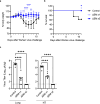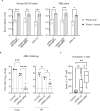SARS-CoV-2 virus lacking the envelope and membrane open-reading frames as a vaccine platform
- PMID: 40360482
- PMCID: PMC12075476
- DOI: 10.1038/s41467-025-59533-4
SARS-CoV-2 virus lacking the envelope and membrane open-reading frames as a vaccine platform
Abstract
To address the need for broadly protective SARS-CoV-2 vaccines, we developed an attenuated a SARS-CoV-2 vaccine virus that lacks the open reading frames of two viral structural proteins: the envelope (E) and membrane (M) proteins. This vaccine virus (ΔEM) replicates in a cell line stably expressing E and M but not in wild-type cells. Vaccination with ΔEM elicits a CD8 T-cell response against the viral spike and nucleocapsid proteins. Two vaccinations with ΔEM provide better protection of the lower respiratory tissues than a single dose against the Delta and Omicron XBB variants in hamsters. Moreover, ΔEM is effective as a booster in hamsters previously vaccinated with an mRNA-based vaccine, providing higher levels of protection in both respiratory tissues compared to the mRNA vaccine booster. Collectively, our data demonstrate the feasibility of a SARS-CoV-2 ΔEM vaccine candidate virus as a vaccine platform.
© 2025. The Author(s).
Conflict of interest statement
Competing interests: Y.K. has received unrelated funding support from Daiichi Sankyo Pharmaceutical, Toyama Chemical, Tauns Laboratories, Inc., Shionogi & Co. LTD, Otsuka Pharmaceutical, KM Biologics, Kyoritsu Seiyaku, Shinya Corporation, and Fuji Rebio. The other authors declare that they have no competing interests.
Figures






Similar articles
-
Efficacy of parainfluenza virus 5 (PIV5)-vectored intranasal COVID-19 vaccine as a single dose primer and booster against SARS-CoV-2 variants.J Virol. 2025 Apr 15;99(4):e0198924. doi: 10.1128/jvi.01989-24. Epub 2025 Mar 21. J Virol. 2025. PMID: 40116505 Free PMC article.
-
Immunogenicity and efficacy of XBB.1.5 rS vaccine against the EG.5.1 variant of SARS-CoV-2 in Syrian hamsters.J Virol. 2024 Oct 22;98(10):e0052824. doi: 10.1128/jvi.00528-24. Epub 2024 Sep 4. J Virol. 2024. PMID: 39230305 Free PMC article.
-
SARS-CoV-2 spike-FLIPr fusion protein plus lipidated FLIPr protects against various SARS-CoV-2 variants in hamsters.J Virol. 2024 Feb 20;98(2):e0154623. doi: 10.1128/jvi.01546-23. Epub 2024 Feb 1. J Virol. 2024. PMID: 38299865 Free PMC article.
-
Immunogenicity and safety of a live-attenuated SARS-CoV-2 vaccine candidate based on multiple attenuation mechanisms.Elife. 2025 Feb 11;13:RP97532. doi: 10.7554/eLife.97532. Elife. 2025. PMID: 39932490 Free PMC article.
-
Severe acute respiratory syndrome-coronavirus-2 spike (S) protein based vaccine candidates: State of the art and future prospects.Rev Med Virol. 2021 May;31(3):e2183. doi: 10.1002/rmv.2183. Epub 2020 Oct 15. Rev Med Virol. 2021. PMID: 33594794 Free PMC article. Review.
Cited by
-
A nasal vaccine candidate based on S2 and N proteins from SARS-CoV-2 generates a broad antibody response systemically and in the lower respiratory tract.Immunol Res. 2025 Aug 27;73(1):125. doi: 10.1007/s12026-025-09675-w. Immunol Res. 2025. PMID: 40859051
References
-
- Wherry, E. J. & Barouch, D. H. T cell immunity to COVID-19 vaccines. Science377, 821–822 (2022). - PubMed
MeSH terms
Substances
Grants and funding
- P01AI165077/U.S. Department of Health & Human Services | NIH | National Institute of Allergy and Infectious Diseases (NIAID)
- JP23wm0125002/Japan Agency for Medical Research and Development (AMED)
- JP233fa627001/Japan Agency for Medical Research and Development (AMED)
- JP233fa827005/Japan Agency for Medical Research and Development (AMED)
LinkOut - more resources
Full Text Sources
Medical
Molecular Biology Databases
Research Materials
Miscellaneous

